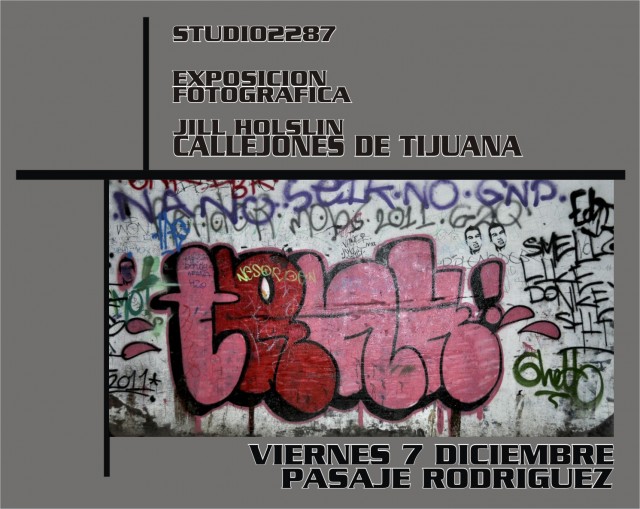On Friday, December 7, I will be debuting my graffiti series at Studio 2287 in the renovated art and culture alleyway of Pasaje Rodriguz in Downtown Tijuana (between 3rd & 4th streets on Avenida Revolucion – enter next to Caliente Casino).
Check out this interview about my show, published by Chad Deal in the San Diego Reader:
The title of my show is ‘Callejones de Tijuana’ or ‘Alleys of Tijuana,’” Holslin writes.
The concept is documentary in nature: my photos document ‘that which remains.’ This refers to the ephemeral nature of graffiti art and practice. Often, graffiti writers will find a wall to paint, go in and paint and leave, never to return to that spot. ‘That which remains’ refers to many different images: the image in the memory of the writer, a video of the process of painting, or a photograph of the piece at a particular moment in time.
Graffiti pieces by their very nature & public location are ever-changing–as other writers will tag onto or over the top of a piece, property owners will buff the wall, or other murals will be painted over the top, partially or entirely covering the original piece. Thus, the ‘meaning’ of graffiti can be registered through its form as a palimpsest, a surface that is used for one piece, scraped off or buffed, and used again, forming layers and layers of various interventions, related to each other through proximity to each other and their common location. The streets and alleys of a city become a living gallery, the pieces, tags and murals are ephemeral rather than static monuments, appearing and disappearing and reappearing over the passage of time.
The original piece always remains, in memory, in documentary form. Graffiti, as a series of layers and layers of interventions, reveals the history of a city, of its everyday life, of the movement and interventions of its most invisible citizens.
My own interest in graffiti began back in the 1990s in San Diego. Like many San Diegans, I began to see Shepard Fairey’s poster interventions all over the city–his Obey Giant posters were popping up everywhere, on electric boxes, on the backs of street signs, on abandoned walls. The images drew attention to themselves through a deliberate absence of explanatory context: the iconic face of Andre the Giant on a poster with no words, no attempt to lead the reader toward a particular interpretation. I loved the openness of this project–the mere act of intervening in public space and posting the image was the artistic act itself.
My reading of Shepard Fairey’s project was determined by the historical and economic context of San Diego at the time. In the 1990s, San Diego was in the midst of one of its many cycles of rising real estate values, and public space was being increasingly privatized and policed, controlled by the interests of the dominant real estate developer culture in San Diego.
Developer culture stamped San Diego with a homogeneous blandness, a dull sameness, while the few truly innovative architectural developments were publicly mocked and derided in the local press. This public culture was reflected on a small scale by real estate agents who would advise new home buyers to be very bland and conservative when remodeling and decorating, to make it easy to sell the home later. Thus, style and imagination was always already determined and constrained by the logic of selling and profit.
As property values began to rise rapidly in San Diego, we witnessed the displacement and destruction of communities–as gentrification moved slowly east from Mission Hills to Hillcrest, University Heights to Normal Heights and North Park, it pushed renters further and further east in its path. The same process happened downtown in the path of Petco Park development, pushing long-term renters out and giving way to new upscale condo & loft development.
Watching all this, I felt that the interventions of Shepard Fairey were a powerful critique of this dominant culture and its tendency to homogenize and control the use of both private property and public space. As a lecturer in cultural studies & literature in the 2000s, I was teaching classes at San Diego State University, and I began to incorporate the study of graffiti and urban art into my courses.
In 2011, after moving to Tijuana, I began to document the urban art and graffiti of the streets of Tijuana, eagerly using my wanderings through the Centro of Tijuana as a way to learn about my newly adopted city.”
My photos were included in a new bilingual book entitled “Welcome Amigos to Tijuana: graffiti on the frontera” published by RM/Conaculta in Mexico City, 2012.
The book will be available for purchase in February 2013.

